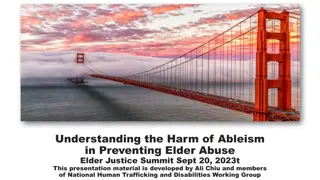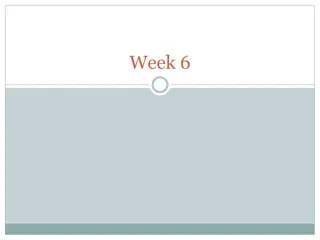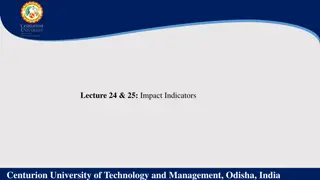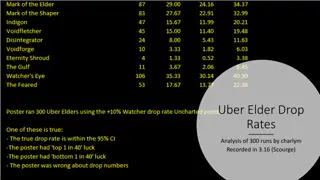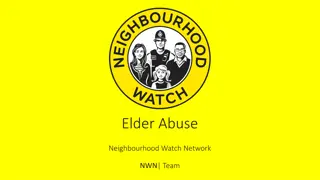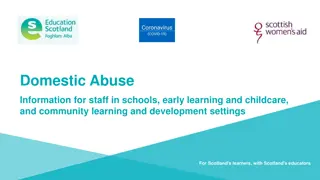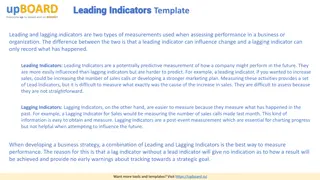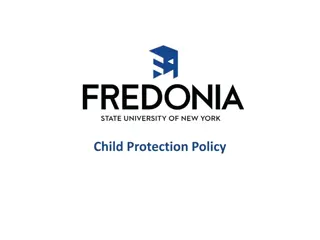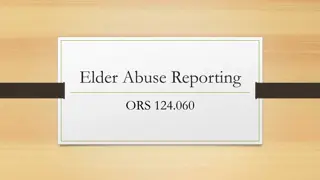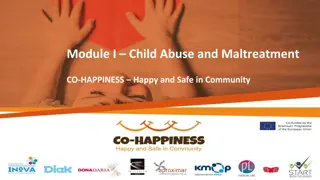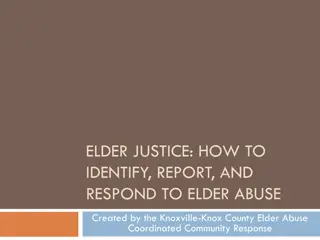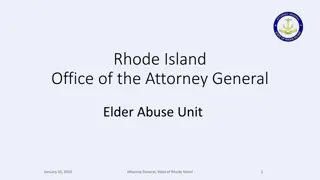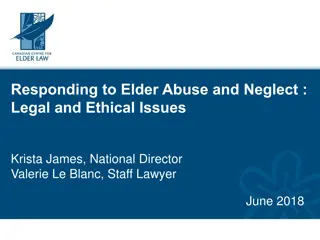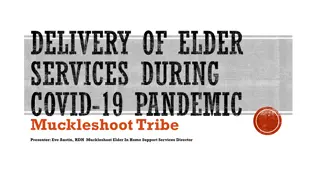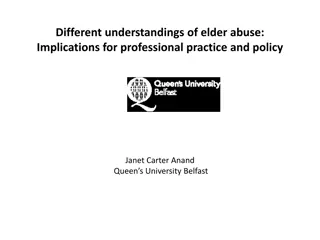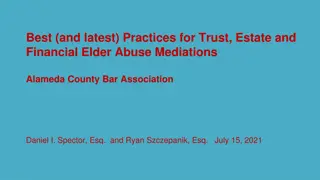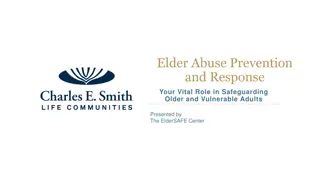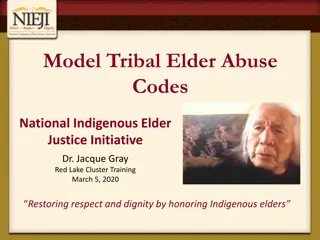Understanding Elder Abuse and Its Indicators
Elder abuse can take various forms including physical, emotional, financial, and more. Anyone can be a victim regardless of gender, income, or ethnicity. Family members are often the perpetrators, but it can also be others in positions of trust. Indicators of elder abuse may vary based on the victim's characteristics. Theft or misuse of a senior's money or property is a common form of abuse. Awareness of these issues is crucial to protecting older adults from harm.
Download Presentation

Please find below an Image/Link to download the presentation.
The content on the website is provided AS IS for your information and personal use only. It may not be sold, licensed, or shared on other websites without obtaining consent from the author. Download presentation by click this link. If you encounter any issues during the download, it is possible that the publisher has removed the file from their server.
E N D
Presentation Transcript
Elder abuse is any action or inaction by self or others that jeopardizes the health or well-being of any older adult and is divided into six categories: physical neglect emotional financial sexual medication 3
Any older person can be a victim of elder abuse It doesn t matter the gender, income level, race, ethnicity or educational level People with physical or mental health issues are at greater risk
Most people who abuse older adults are relatives but can also be a friend, neighbour, paid care provider, landlord or any individual with a position of trust, power or authority. 71% of abusers were a spouse, adult son or adult daughter (Statistics Canada 2002) Can be a continuation of spousal abuse Older women are more likely to be abused by their husbands; Older men are more likely to be abused by their sons.
History of spousal abuse Family dynamics Isolation Troubled relatives, friend or neighbors Inability to cope with long-term care giving Institutional conditions Ageism & lack of knowledge about the aging process Society s acceptance of violence
Indicators for different types of elder abuse may differ based on a victim s characteristics, such as: Age Cognitive ability Gender Past experiences Community support Family structure Abuse or elder abuse tactics used 7
Theft or misuse of a seniors money or property. Indicators: Standard of living not in keeping with income or assets Theft of property Unusual activity in bank account Forged signatures on financial documents Coercion used in signing of wills or releasing property; overdue bills Limiting a senior s access to his or her own accounts 8
Actions or statements that cause emotional anguish, diminished self-esteem or dignity. Fear Anxiety Depression Withdrawal Cowering Secrecy Fearful interaction with caregiver Caregiver speaking on behalf of senior Not allowing privacy Physical signs of isolation 9
Action that causes physical discomfort, pain or injury. Unexplained injuries such as bruises, burns or bites Missing hair Untreated medical problems or history of injury Harming or threatening to harm pets Confinement 10
Intentional or unintentional failure to provide for the basic needs of someone. Inappropriate or dirty clothing Poor hygiene Dehydration Unsafe living conditions Lack of social contact Irregular medical appointments Lack of, or poor conditions of, dentures, glasses, or hearing aids 11
Unwanted sexual behaviour including sexual comments, exploitive use of pornography, fondling or sexual assault. Pain Bruising or bleeding in the genital or chest area Sexually transmitted illnesses Recent depression Recent incontinence 12
Intentional or unintentional misuse of medications and prescriptions, such as withholding or providing doses that cause bodily harm, sedation or other adverse effects. Changes in mental ability or physical ability Decline in general health status including Confusion Poor balance Falling Depression Recent incontinence Agitation 13
Complex issue which makes it difficult to recognize. Own beliefs, values and biases Lack of awareness who is out there No visible or observable signs Plausible explanations for visible signs Not all forms are recognizable Aging considerations Victim denial 14
What are some reasons that seniors are reluctant to report abuse? Love for the abuser Hope for change Fear of institutionalization Fear of losing a caregiver Unable to report Hopelessness Shame Guilt Unaware of resources 15
Twenty-four percent of respondents did not tell anyone about the abuse they were experiencing. (2006) 54% said their abuse was reported to the police. Of those, 33% said the report was made by someone other than themselves. (2006)
Promote access to community services Respect confidence Help her/him plan for future safety Believe her/him and validate the experience P Respect her/his autonomy Acknowledge the injustice 17
Acknowledge: Barriers: Urgency: Screen: Empower: Refer: Accumulate/document evidence of suspected abuse . Speak to the senior about any concerns he or she may have about fear or retaliation, with drawl of support and confidentiality. Assess if basic life necessities are being provided or whether there is an immediate risk of physical harm. Assess the senior s ability to make an informed decision and his/her desire to receive help. Inform the senior of the right to live free of abuse and the resources available to support this. Establish a safety plan. Seek support or consultation from other professionals and suggest resources to the senior.
4 R Response Model Recognize Recognize Recognize Respond Refer Respond Front - -line Staff Front line Staff Reconnect Respond Reconnect Reconnect Refer Refer 19
Criminal Code of Canada Physical and sexual abuse Neglect Property theft Breach of trust Breach of power of attorney Extortion, fraud, false pretences intimidation Criminal Code of Canada Physical and sexual abuse Neglect Property theft Breach of trust Breach of power of attorney Extortion, fraud, false pretences intimidation Protection Against Family Violence Emergency Protection Order Access to premise Protection Against Family Violence Act Emergency Protection Order Access to premise Act 20
Mental Health A danger to self or others Cognitive impairment Mental Health Act A danger to self or others Cognitive impairment Act Family Law Act Obtaining guardianship of grandchildren Financial worry of leaving a spouse Obtaining support orders Family Law Act Obtaining guardianship of grandchildren Financial worry of leaving a spouse Obtaining support orders 21
Public Health Act Individual can be removed from a home Investigation to identify possible situation of neglect Public Health Act Individual can be removed from a home Investigation to identify possible situation of neglect Adult Guardianship and Trusteeship Outlines decision making options Adult Guardianship and Trusteeship Act Outlines decision making options Act Protection for Persons in Care Outlines the duty to report within publicly funded Mandatory reporting required Protection for Persons in Care Act Outlines the duty to report within publicly funded Mandatory reporting required Act 22
Freedom Of Information and Privacy Act Governs and protects the privacy of individuals Freedom Of Information and Privacy Act Governs and protects the privacy of individuals Health Information Act Outlines rules and limitations for the collection, use, or disclosure of health information Health Information Act Outlines rules and limitations for the collection, use, or disclosure of health information Powers of Attorney Financial and personal decision Powers of Attorney Act Financial and personal decision making tools Act and and Personal Directives making tools Personal Directives Act Act Handout Handout - - Privacy Legislation Guide Privacy Legislation Guide 23
Decisions Made by you Decisions Made by you Decisions Made by Court Decisions Made by Court Personal Personal Directive Supportive Decision Making Specific Decision Making (one time) Enduring Power of Attorney Guardianship (AGTA) Co-Decision Making Financial Trusteeship (AGTA) After Death Will Intestate Succession Act 24
Police Senior s Centre Health care Rural Crime Watch Victim of Elder Abuse Victim services Hospital ? SPA 25
What is a safety plan? What are the strategies? Why do we encourage safety planning? How good are safety planning measures? When should a safety plan be revisited? Who should keep the safety plan? What are some of the legal tools available? What s your role in safety planning? 26
Kristel Kirstein Outreach Worker: 403 Kristel Kirstein at Canadian Mental Health Seniors 403- -504 504- -1811 ext. 114 1811 ext. 114 Alberta Elder Abuse Awareness Network (AEAAN): www.albertaelderabuse.ca Alberta Elder Abuse Awareness Network (AEAAN): Older Adult Knowledge Network: Older Adult Knowledge Network: www.oak-net.ca Canadian Network for the Prevention of Elder Abuse: www.cnpea.ca Canadian Network for the Prevention of Elder Abuse: Alberta Family Violence Information Line: 310-1818 (toll-free, 24 hours) www.humanservices.alberta.ca/abuse-bullying/14839.html Alberta Family Violence Information Line: HealthLink HealthLink Alberta: Alberta: 1-866-408-5465 27
CRANE (Community Response To Abuse and (403) 529 Medicine Hat Police Victim Assistance Unit (403) 529 Protection for Persons in Care 1 1- -888 Medicine Hat Women s Shelter (24 hour Crisis Line) (403) 529 Safeguards for Vulnerable Adults Information and Reporting Line 1 1- -888 CRANE (Community Response To Abuse and Neglect of Elders) (403) 529- -4798 Medicine Hat Police Victim Assistance Unit (403) 529- -8480 Protection for Persons in Care 888- -357 Medicine Hat Women s Shelter (24 hour Crisis Line) (403) 529- -1091 Safeguards for Vulnerable Adults Information and Reporting Line 888- -357 Neglect of Elders) 4798 8480 357- -9339 9339. 1091 357- -9339 9339


